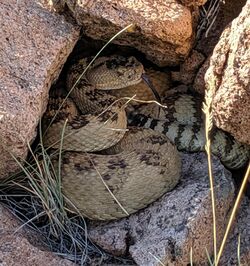Great Basin rattlesnake
Topic: Biology
 From HandWiki - Reading time: 3 min
From HandWiki - Reading time: 3 min
| Great Basin rattlesnake | |
|---|---|

| |
| Scientific classification | |
| Domain: | Eukaryota |
| Kingdom: | Animalia |
| Phylum: | Chordata |
| Class: | Reptilia |
| Order: | Squamata |
| Suborder: | Serpentes |
| Family: | Viperidae |
| Genus: | Crotalus |
| Species: | C. lutosus
|
| Binomial name | |
| Crotalus lutosus (Klauber, 1930)
| |
| Synonyms | |
The Great Basin rattlesnake (Crotalus lutosus)[3] is a venomous pit viper species found in the Great Basin region of the United States .[4]
Taxonomy and naming
The Great basin rattlesnake was first formally named by Laurence Monroe Klauber in 1930 as a subspecies of Crotalus confluentus (now known as Crotalus viridis).[5] It is commonly considered a subspecies of Crotalus oreganus.[6][4] The type locality is "10 miles northwest of Abraham on the Road to Joy, Millard County, Utah."[1]
The Grand Canyon rattlesnake (C. abyssus or C. oreganus abyssus) was subsumed within C. lutosus in 2016.[7]
Description
Adult specimens are 66–121 cm (26–48 in) in overall length,[3] but rarely exceed 1 m (3 ft 3 in).[8] The males grow larger than the females.[3]
On the subject of scalation, one of the more distinctive characteristics of this subspecies is that it has three or more internasal scales – something that it has in common with C. viridis.[8]
The color pattern usually consists of a buff, pale gray, pale brown, olive brown or yellowish brown ground color (hence the name, "lutosus," meaning "muddy"), overlaid with a series of 32-49 dorsal blotches. These blotches are dark brown to black in color, with pale centers and pale borders, and are often irregular in shape and wider than they are long. There is also a series of lateral blotches that are indistinct anteriorly, but become more distinct posteriorly and eventually merge with the dorsal blotches to form crossbands. Older specimens sometimes have a faded pattern, or they may have uniformly black blotches, with the dorsum of the head also being black.[8]
Distribution and habitat
The United States in the Great Basin region. Its range includes Idaho south of lat. 44° North, Utah west of long. 111° West, Arizona west and north of the Colorado River as well as the north rim of the Grand Canyon, the entire state of Nevada (excluding Esmeralda, Nye and Clark counties), California east of the Sierra Nevada from Lower Klamath Lake south to below Lake Mono, Oregon south and east of the line Upper Klamath Lake–Fort Rock–Burns–Council (Idaho).[9]
Inhabits the dry and barren areas of the Great Basin region, being found on hills, summits and old lake benches. They are said to prefer southern exposures among rocks and boulders on hillsides and buttes, low foothills, mountainsides, open deserts, alfalfa fields and valley floors.[3]
They are most commonly seen by humans while hiking [10] but also on the side of the road at night looking for prey.
Diet
Crotalus lutosus feeds on amphibians, reptiles, birds, bird eggs, and mammals.[11]
Reproduction
Young are born alive in broods of 3 to 13.[11]
Conservation status
The Great Basin rattlesnake is protected in Utah.[11]
References
- ↑ 1.0 1.1 McDiarmid RW, Campbell JA, Touré T. 1999. Snake Species of the World: A Taxonomic and Geographic Reference, vol. 1. Herpetologists' League. 511 pp. ISBN:1-893777-00-6 (series). ISBN:1-893777-01-4 (volume).
- ↑ Ashton, Kyle G.; de Queiroz, Alan (2001). "Molecular systematics of the western rattlesnake, Crotalus viridis (Viperidae), with comments on the utility of the D-loop in phylogenetic studies of snakes". Molecular Phylogenetics and Evolution 21 (2): 176–189. doi:10.1006/mpev.2001.1013. PMID 11697914.
- ↑ 3.0 3.1 3.2 3.3 Wright AH, Wright AA. 1957. Handbook of Snakes of the United States and Canada. Comstock Publishing Associates, Ithaca and London. (7th printing, 1985). 1105 pp. ISBN:0-8014-0463-0.
- ↑ 4.0 4.1 "Crotalus oreganus lutosus Klauber, 1930". Integrated Taxonomic Information System. https://www.itis.gov/servlet/SingleRpt/SingleRpt?search_topic=TSN&search_value=683066. Retrieved 23 August 2020.
- ↑ Klauber, L.M. 1930. New and Renamed Subspecies of Crotalus confluentus Say, with Remarks on Related Species. Trans. San Diego Soc. Nat. Hist.
6 (3): 95-144, including Plates 9-12, 1 map. ("Crotalus confluentus lutosus, subsp. nov.", pp. 100–106 + Plate 10, figure 1.) - ↑ Crotalus oreganus lutosus - Great Basin Rattlesnake at California Herps. Accessed 19 June 2007.
- ↑ Crotalus lutosus at the Reptarium.cz Reptile Database. Accessed 23 August 2020.
- ↑ 8.0 8.1 8.2 Campbell JA, Lamar WW. 2004. The Venomous Reptiles of the Western Hemisphere. Comstock Publishing Associates, Ithaca and London. 870 pp., 1500 plates. ISBN:0-8014-4141-2.
- ↑ Klauber LM. 1997. Rattlesnakes: Their Habitats, Life Histories, and Influence on Mankind. Second Edition. First published in 1956, 1972. University of California Press, Berkeley. ISBN:0-520-21056-5.
- ↑ Great Basin Rattlesnakes in Bryce Canyon.
- ↑ 11.0 11.1 11.2 Hubbs, Brian, and Brendan O'Connor. 2012. A Guide to the Rattlesnakes and other Venomous Serpents of the United States. Tricolor Books. Tempe, Arizona. 129 pp. (Crotalus oreganus lutosus, pp. 28-29.)
Wikidata ☰ Q5188961 entry
 |
 KSF
KSF